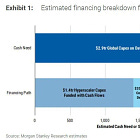Publishing note: Random Walk will be on vacation next week
More with less, the supercore inflation prelude
more with less, manufacturing edition
. . . homebuilding, less with more
revenue/employee update, with an AI wrinkle
👉👉👉Reminder to sign up for the Weekly Recap only, if daily emails is too much. Find me on twitter, for more fun. 👋👋👋Random Walk has been piloting some other initiatives and now would like to hear from broader universe of you:
(1) 🛎️ Schedule a time to chat with me. I want to know what would be valuable to you.
(2) 💡 Find out more about Random Walk Idea Dinners. High-Signal Serendipity.Doing more with less
Doing more with less is a big Random Walk theme because it’s a big everything theme.
Doing more with less is the only trade that matters.
So, here are some charts about that. But first, because it’s topical, a supercore inflation prelude.
ICYMI
A supercore prelude
Inflation came in “hot,” but as with all monthly wiggles, it’s best not to draw any conclusions.
I say that, even if the “hot” part is the one part Random Walk has been warning about for ~2 years: Mind the Supercore.
Supercore inflation is basically services-less-housing, so it’s pretty sensitive to labor costs. If you’ve got fewer people to do the work (and demand stays constant or grows) then labor costs rise. That’s why the Rock n’ Hard Place of the closing the open border is such a rock n’ hard place.
It’s also the flipside of the relatively fragile and narrow economy that we’ve had for the past few years:
Employment growth has been driven almost entirely by the acyclical parts of the economy (in red), i.e. healthcare.
The pro-cyclical parts (in black) just haven’t been adding much headcount, at all. Fewer people is no problem if you’re not growing all that much.1
But, back to the supercore, take a look at these “hot” categories of inflation:
Lawncare:
Auto repair:
Hospital services:
Does that look like a “worker shortage” flaring up again?
I mean, it certainly could be. Around 1/3 of landscapers are “foreign born” workers.
Again, it’s too soon to tell. Some of this could be a passthrough of tariff costs, and healthcare costs are always a bit screwy in the CPI. But it also might be plain-old up-and-to-the-right-expansion.
And, if one was concerned that slowing people-growth would increase the costs of labor-intensive services, putting a price-dampener on any growth, well, this is what one would expect.
It’s an uncomfortable reality for all political tribes, but it’s my story, and I’m sticking to it.
More with less
Now that we’ve refreshed the table-setting, on to the charts
More with less, manufacturing edition
Here’s a wrinkle in the “reshore manufacturing” story that I just discovered.
It turns out that the number of manufacturing firms has skyrocketed—it’s just not the sort of manufacturing that needs many people:
Manufacturing firms have been propagating like bunnies since 2012, but the number of manufacturing workers is pretty much flat over that same period.
Put another way, we have about the same number of manufacturing firms as we had in the 90s, but with about 5 million fewer workers. That’s pretty wild.
Unsurprisingly, some of the fastest-growing manufacturing establishments also happen to be the least labor-intensive:
Electronics manufacturing has grown~12%, but the contribution to the manufacturing labor force is actually negative.
This all makes me somewhat more optimistic about the possibility of reshoring. To be clear, we're definitely in short supply of skilled labor as well, but people-shortages are, in general, less of a headwind than I would have expected.
. . . home building
On a somewhat related note: a lot of high-profile work has been done on the so-called ‘mystery’ of lower construction productivity.
While other industries have gotten more productive, construction has not.
Construction “value added” per construction worker has gotten steadily worse since the 60’s.
The observation has become high profile, because some people have attributed the productivity decline to the broader motif of the zoning-driven “housing shortage,” (which around these parts, we know is not actually a real thing). Zoning makes big housing projects more expensive and less possible, so builders go with smaller developments that are less efficient from a labor standpoint.
But, looking at that manufacturing chart above, I wonder if there is a simpler explanation for the decline in construction productivity: the steady supply of cheap construction labor.
Why invest in automation and/or otherwise get more efficient, if you don’t have to? The same can be said of “food manufacturing,” which, unlike electronics, has had an outsized contribution to manufacturing job-growth . . . and also employs a whole lot of cheap, immigrant labor.
Necessity is the mother of invention, after all.
. . . revenue per employee
And finally, while it’s not surprising, here’s a nice visual on how the whole economy has gotten “more productive” on a revenue/employee basis:
Across the entire index, revenue per employee has improved by about 60% since 1991.
To be honest, I'm pretty shocked to see healthcare as being one of the biggest revenue/employee gainers, and I'm not really sure how to interpret that, but that’s what the chart shows.
Anyways, the hope is that AI begins to change all of this. With great leaps forward in productivity, revenue per employee should really start to cook. In fact, we’ve already seen some examples of fairly small teams in startup land, generating astronomical revenue growth.
That being the case, this too was a little surprising:
AI companies are actually generating less revenue/employee than non-AI companies.
The difference is especially stark at later stage companies, as well, which is kinda the opposite of what one would expect.
Obviously, I wouldn’t read too much into this, (a) because SVB’s data reflects a tiny slice of the overall revenue picture; (b) if anything, it’s probably a function of where the VC funding is going (i.e. to AI companies), which is also then where the hiring goes (because AI is a jobmaker, not a job-taker).
But, it was a fun chart, all the same.
Previously, on Random Walk
Private Credit and Insurance, two peas in a pod (reprise), and a chart dump on default rates
five charts on the rise of private credit in life insurance
Energy in 1776
It’s July 4th, so Happy Birthday America, and we’re going to keep it light and only semi-topical.
Random Walk is an idea company dedicated to the discovery of idea alpha. Find differentiated data, perspectives and people, and keep your information mix lively. A foolish consistency is the hobgoblin of small minds. Fight the Great Idea Stagnation. Join Random Walk. Follow me on twitter. Follow me on substack:
Another interesting wrinkle is that big firms are doing all the hiring, while small firms are not:
Small-firm hiring, as measured by the Russell 2000 or establishment size, has dropped off substantially, although it’s really a longer-run trend, dating back to 2016 (which itself, appears to have been a post-GFC catch-up).


























I liked what a British commentator calls immigration for labor-intensive industries="Human Quantitative Easing".
As far as I can tell people are paying for twice as much “lawn care” as they actually need.